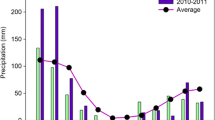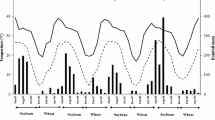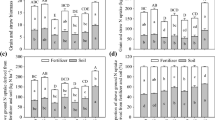Abstract
In the recent past considerable attention is paid to minimize dependence on purchased inputs such as inorganic nitrogen fertilizer. Green manure in the form of flood-tolerant, stem-nodulatingSesbania rostrata andAeschynomene afraspera is an alternative N source for rice, which may also increase N use efficiency. Therefore research was conducted to determine the fate of N applied to lowland rice (Oryza sativa L.) in the form ofSesbania rostrata andAeschynomene afraspera green manure and urea in two field experiments using15N labeled materials.15N in the soil and rice plant was determined, and15N balances established. Apparent N recoveries were determined by non-tracer method.
15N recoveries averaged 90 and 65% of N applied for green manure and urea treatments, respectively. High partial pressures of NH3 in the floodwater, and high pH probably resulted from urea application and favoured losses of N from the urea treatment. Results show that green manure N can supply a substantial proportion of the N requirements of lowland rice. Nitrogen released fromSesbania rostrata andAeschynomene afraspera green manure was in synchrony with the demand of the rice plant. The effect of combined application of green manure and urea on N losses from urea fertilizer were also investigated. Green manure reduced the N losses from15N labeled urea possibly due to a reduction in pH of the floodwater. Positive added N interactions (ANIs) were observed. At harvest, an average of 45 and 25% of N applied remained in the soil for green manure and urea, respectively.
Similar content being viewed by others
References
Becker M, Alazard D and Ottow J C G 1986 Mineral nitrogen effect on nodulation and nitrogen fixation of the stem-nodulating legumeAeschynomene afraspera. Z. Pflanzenernaehr. Bodenkd. 149, 485–491.
Becker M, Diekmann K H, Lahda J L, DeDatta S K, and Ottow J C G 1991 Effect of NPK on growth and nitrogen fixation ofSesbania rostrata as green manure for lowland rice (Oryza sativa L.). Plant and Soil 132, 149–158.
Beri V, Meelu O P and Khind C S 1989 Studies onSesbanai acculeata Pers. as green manure for N accumulation and substitution of fertilizer N in wetland rice. Trop. Agric. (Trinidad) 66, 209–212.
Bremner J M 1965 Inorganic forms of nitrogen.In Methods of Soil Analysis. Ed.C ABlack. pp 1179–1223. American Society of Agronomy, Madison, WI.
Bremner J M and Mulvaney C S 1982 Total nitrogen.In Methods of Soil Analysis. Eds. A LPage et al. Agro. 9(2). pp 699–709. American Society of Agronomy, Madison, WI.
Buresh R J, Austin E R and Craswell E T 1982 Analytical methods in15N research. Fertil. Res. 3, 37–62.
Buresh R J 1987 Relative susceptibility of conventional and experimental nitrogen sources to ammonia loss from flooded rice fields. Fertil. Res. 13, 139–153.
DeDatta S K and Buresh R J 1989 Integrated nitrogen management in irrigated rice. Adv. Soil Sci. 10, 143–164.
DeDatta S K, Fillery I R P, Obcemea W N and Evangelista R C 1987 Floodwater properties, nitrogen utilization, and nitrogen-15 balance in a calcarous lowland rice soil. Soil Sci. Soc. Am. J. 51, 1355–1362.
Denmead O T, Freney J R and Simpson J R. 1982. Dynamics of ammonia volatilization during furrow irrigation of maize. Soil Sci. Soc. Am. J. 46, 149–155.
Denmead O T, Freney J R and Simpson J R 1983 Dynamics of ammonia volatilization during furrow irrigation of maize. Soil Sci. Soc. Am. J. 47, 618.
Douglas L A and Bremner J M 1970 Extraction and colorimetric determination of urea in soils. Soil Sci. Soc. Am. Proc. 34, 859–862.
Dreyfus B, Garcia J L and Gillis M 1988 Characterization ofAzorhizobium caulinodans gen nov., sp. nov., a stem nodulating, nitrogen fixing bacterium isolated fromS. rostrata. Int. J. System. Bacteriol. 38, 89–98.
Ghai S K, Rao D L N, Batra L 1988 Nitrogen contribution to wetland rice by green manuring with Sesbania spp. in an alkaline soil. Biol. Fertil. Soils 6, 22–25.
Harmsen K and Moraghan J T 1988 A comparison of the isotope and differences methods for determining nitrogen fertilizer efficiency. Plant and Soil 105, 55–67.
HuangZhi-Whu and Broadbent F E 1989 The influences of organic residues on utilization of urea N by rice. Fertil. Res. 18, 213–220.
Jenkinson D S and Fox R H 1985 Interaction between fertilizer nitrogen and soil nitrogen — the so-called “priming effect”. J. Soil Sci. 36, 425–444.
John P S, Buresh R J, Pandey R K, Prasad R and Chua T T 1989 Nitrogen-15 balances for urea and neem coated urea applied to lowland rice following two cowpea cropping systems. Plant and Soil 120, 233–241.
Kai H, Ahmad Z and Harada T 1973 Factors affecting immobilization and release of nitrogen in soil and chemical characteristics of the nitrogen newly immobilized. Soil Sci. Plant Nutr. 19, 275–286.
Ladha J K, Miyan S and Garcia M 1989Sesbania rostrata as a green manure for lowland rice: Growth, N2 fixation,Azorhizobium sp. inoculation and effects on succeeding crop yields and nitrogen balance. Biol. Fertil. Soils 7, 191–197.
Morris R A, Furoc R E, Rajbhandari N K, Marqueses E P and Dizon M A 1989 Rice response to waterlog-tolerant green manures. Agron. J. 81, 803–809.
Nagarajah S, Neue H U and Alberto M C R 1989 Effect ofSesbania, Azolla and rice straw incorporation on the kinetics of NH4, K, Fe, Mn, Zn and P in some flooded rice soils. Plant and Soil 116, 37–48.
Rinaudo G, Dreyfus B, and Dommergues Y 1983Sesbania rostrata green manure and the nitrogen content of rice crop and soil. Soil Biol. Bicohem. 15, 111–113.
Vlek P L G and Byrnes B H 1986 The efficacy and loss of fertilizer N in lowland rice. Fertil. Res. 9, 131–147.
Watanabe I, Ventura W, Mascarina G and Eskew D L 1989 Fate ofAzolla spp. and urea nitrogen applied to wetland rice (Oryza sativa L.). Biol. Fertil. Soils 8, 102–110.
Westcott M P and Mikkelsen D S 1985 Comparative effects of an organic and inorganic nitrogen source in flooded soils. Soil Sci. Soc. Am. J. 49, 1470–1475.
Yoshida S, Forno D A, Cock J H and Gomez K A 1976 Laboratory Manual for Physiological Studies of Rice. 3rd ed. International Rice Research Institute, P.O. Box 933, Manila, Philippines.
Author information
Authors and Affiliations
Additional information
Contribution from IRRI, Los Baños, Philippines and Justus-Liebig-University, Giessen, Germany
Contribution from IRRI, Los Baños, Philippines and Justus-Liebig-University, Giessen, Germany
Rights and permissions
About this article
Cite this article
Diekmann, K.H., De Datta, S.K. & Ottow, J.C.G. Nitrogen uptake and recovery from urea and green manure in lowland rice measured by15N and non-isotope techniques. Plant Soil 148, 91–99 (1993). https://doi.org/10.1007/BF02185388
Received:
Accepted:
Issue Date:
DOI: https://doi.org/10.1007/BF02185388




